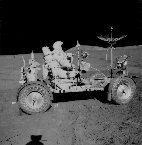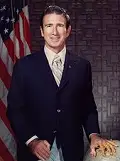Jim Irwin: Former Astronaut and Religious Leader

He was born on March 17, 1930, in Pittsburgh. His fascination with flight dated to age 4, when he had a ride in a plane once used for barnstorming. He early identified the goal of walking on the Moon as well. His family moved to Florida and later Salt Lake City, and he attended high school there, graduating from East High School in 1947. He graduated from the U.S. Naval Academy in 1951 but was at that time not accepted for pilot training. A few years later, he joined the Air Force test pilot school, also attending the University of Michigan and in 1957 earning a master's degree in aeronautical and instrumentation engineering. Irwin avoided serious harm in 1961 while on a training mission with a student pilot. The plane crashed, and Irwin sustained compound fractures that nearly resulted in his losing a leg. He made a full recovery and eventually logged more than 7,000 hours of flying time. He was one of the National Aeronautics and Space Administration's Astronaut Group 5, announced in 1966. After serving on the support crew for Apollo 10 and on the backup crew for Apollo 12, Irwin flew into space aboard Apolllo 15 and, as Lunar Module Pilot, walked on the Moon. He and Commander Dave Scott landed on the lunar surface on July 30, 1971. Because of the dust that the landing craft was kicking up, the landing itself was a bit bumpy, to which Irwin yelled "Bam!" after they touched down. 
One of the big highlights of this mission was the debut of the Lunar Roving Vehicle. The 460-pound rolling craft could be folded into a space 5 feet by 20 inches and could carry a total of 1500 pounds, including the two astronauts. Each wheel had its own 200-watt electric motor. The craft could top a speed of 8 miles per hour. As had previous Apollo crews, Irwin and Scott collected a number of samples of lunar dust and rocks, the utility of the Rover giving them the ability to range
relatively far and wide from their landing craft. They reunited with Al Worden in the Command Module, leaving behind a TV camera, which had captured their ascent, and a plaque with the names of astronauts and cosmonauts who had died. The crew were involved in a controversy after they landed. All three had agreed to carry postal covers to the Moon and, after returning them to Earth, hand them over to a West German stamp dealer, who planned to sell them. The dealer paid each astronaut for doing this, and the crew had planned to use the money as a nest egg for their children. However, they did not have permission from NASA to do so. When the crew's actions became public knowledge, they received official reprimands from NASA and were removed as the backup crew for Apollo 17. None of them flew in space again. 
Irwin had already decided to retire from the Navy and NASA, and he did so in 1972. In that year, he founded the High Flight Foundation, to advance the message of Christianity through religious retreats and trips to the Holy Land. Irwin said that he had a religious epiphany while on the lunar surface. The following year, he led the first of several expeditions to Mount Ararat, Turkey, in search of the remains of Noah's Ark. He reached the summit in 1982; on the way down, he sustained serious injuries after a fall on a glacier and had to be removed on horseback. He returned to the mountain twice more in subsequent years. In 1983, he published the book More Than Earthlings, a collection of religious essays and meditations. He had in 1973 written To Rule the Night, an account of his lunar journey. Irwin had encountered slight heart difficulties while on the Moon. Back on Earth, he suffered three major heart attacks, all while engaged in athletic activities. A keen handball player, he suffered the first of the three attacks in 1973. His second heart attack came in 1986, while he was out running. His third heart attack, suffered while on a bicycle ride in 1991, resulted in his death. The eighth man to walk on the Moon, he was the first of those to die. Irwin was married twice and had five children. |
|
Social Studies for Kids
copyright 2002–2025
David White



 Among the rocks that they brought back was the so-called Genesis Rock, thought to have been part of the lunar crust from earliest times.
Among the rocks that they brought back was the so-called Genesis Rock, thought to have been part of the lunar crust from earliest times.
